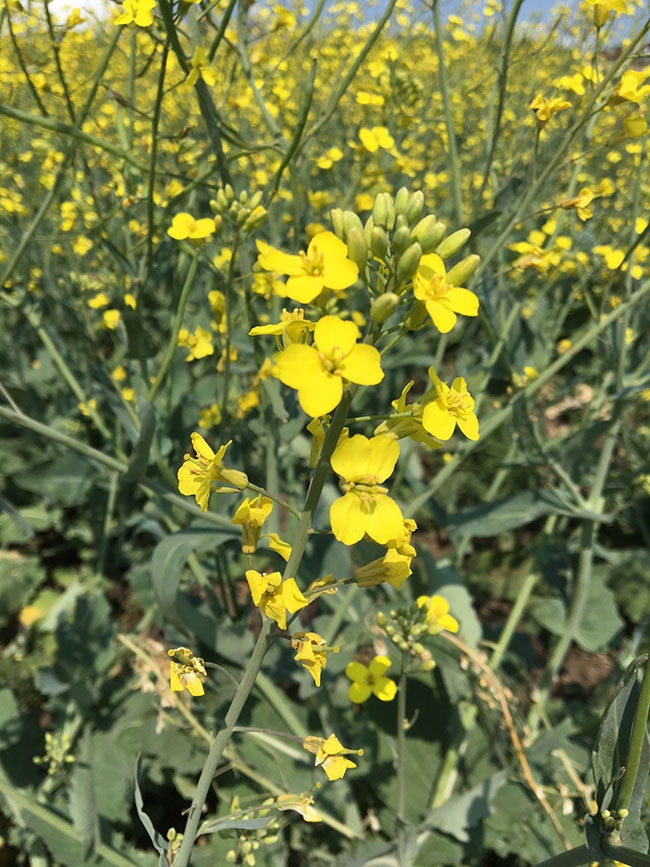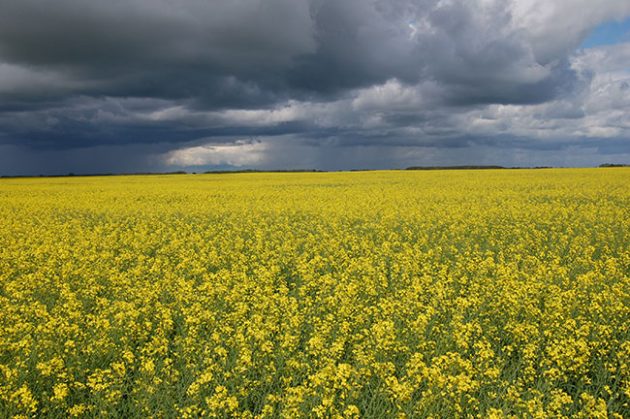
Features
Agronomy
Canola
Weather impacts on canola quality
Along with good agronomic practices, weather and growing conditions impact harvest seed yield and quality of annual field crops including canola. Although predicting growing season weather remains a challenge, a team of researchers wanted to know if it might be possible to predict canola quality prior to harvest by looking at growing season weather and environmental conditions during the crop year.
July 3, 2018 By Donna Fleury
 Canola is known to be a very “plastic” crop.
Canola is known to be a very “plastic” crop. Researchers at the University of Manitoba conducted at two-year project to try to answer questions around weather and canola seed quality. The overall objective of the project was to quantify the effects of growing season weather on canola quality for the purpose of predicting canola quality prior to harvest.
“We were trying to quantify the impact of the environment on different genotypes or varieties of canola, and whether or not the interaction between canola genotype and environment was significant,” explains Paul Bullock, professor and head of the department of soil science at the university. “The study included two different approaches to collecting data. In one, a few sites seeded to canola were intensively monitored for a large range of weather factors. In the other, a large number of canola samples from the Canadian Grain Commission (CGC) harvest survey were analyzed. The samples selected were just those that provided a legal location of the field of origin so that a nearby weather station could be used as a source of weather data, as well as the planting date so that the stages of the canola phenological development at each field could be modelled.”
Graduate student Taryn Dickson led the project. She is now with the Canola Council of Canada.
For the intensively monitored sites, a large number of weather parameters were measured and data on canola development stage was collected. The parameters monitored ranged from growing degree days and calendar days to temperature, heat stress measures, evaporative demand and precipitation at various stages of development from the time of seeding until harvest. Critical canola quality parameters were measured such as oil content, protein content, chlorophyll, glucosinolates, and specific fatty acids, including oleic, linoleic and linolenic acid content.
The CGC harvest survey samples also underwent the same quality analysis. Specific canola varieties were selected to determine the effects of genotype on quality. Weather databases were used to determine growing season conditions at each sample site and to generate a similar set of weather parameters for factors such as precipitation, heat stress and water stress at different stages of canola development at each location.
“We used a partial least squares (PLS) statistical analysis approach to incorporate the large number of weather parameters collected and determine whether or not they could help us predict crop quality ahead of harvest,” Bullock explains. “[Graduate student and project lead] Taryn worked alongside the researchers at the CGC Research lab to do the canola quality work. Although the results were not quite what was expected, the outcomes can be considered good news.”
Overall, the PLS models could only predict between seven and 49 per cent of the variation in quality of canola based on the weather information. This is not a very strong correlation, and shows that the weather parameters make up only a portion of the total environmental impact on canola quality parameters. Other important factors including soil characteristics, available plant nutrients and overall farm management practices.
“The takeaway is that this is a good news story,” Bullock adds. “Although no one will argue that weather doesn’t have an impact on quality, this study emphasizes that the impact of growing season weather on canola is perhaps smaller than for other crops. Canola is known to be a very ‘plastic’ crop able to compensate for weather conditions ranging from hail and wind damage to moisture extremes and seems to be more robust. These results showed fairly muted responses in canola quality to the impact of weather.”
Shifting focus
With the completion of this project on canola, Bullock decided to conduct another wheat quality study, based on some earlier work about 10 years ago. The project will focus on how environmental conditions affect the production of wheat proteins, protein quality and gluten strength.
“[With these projects], I’ve come to the conclusion that you can not predict crop quality based on weather parameters alone. Although weather is important, there are many other factors that impact quality: soil characteristics, amount of N fertilizer used, type of seeding implement, [planting date], and other agronomic practices,” he continues. “Therefore, we have moved beyond the whole notion of predicting quality based on weather and are looking at other strategies. The systems are very complex and attempting to develop a weather-based quality model may not be the most useful approach.”
The wheat-focused study is now in its third year, and Bullock expects to be able to report on the results in another year. “We are looking at a different approach to weather conditions by placing weather into broad categories or clusters and then trying to determine whether or not there is any broad impact on wheat quality in terms of grade, protein, and quality parameters such as gluten strength in bread dough,” Bullock says. “We are looking at weather patterns at different times of the growing season to see if we can find clusters that have a strong and consistent impact. For example, hot and dry conditions, or dry spring and wet summer conditions, and other patterns.”
For now, although growers can’t control the weather, they can focus on implementing good agronomic practices to minimize the impacts of other variables and maximize canola quality. In the future, weather may be able to be used to predict specific quality trends such as protein or gluten strength in wheat, but for crops like canola it is other factors that will play a bigger role in quality.
